Where you see this button
Spider Collector's Journal (17th page: 2007) Copyright © 2007 by Rod Crawford
As explained on the first page, most of these notes of fun
(and not so fun) trips to collect spiders for research at the Burke
Museum, often accompanied by capable field volunteer Laurel Ramseyer, appeared in Scarabogram, newsletter of "Scarabs:
The Bug Society," in their original forms. Dates of field
trips head each paragraph. Maps showing the location of sites within Washington
state follow the grid system outlined in the Washington
Spider Checklist. RETURN TO INDEX
Where you see this button ![]() in a
field trip account, click it to get a page of collecting site photos!
in a
field trip account, click it to get a page of collecting site photos!
 |
![]() 16 IV 2007: I'd been hoping to visit Stone Quarry Canyon (south of Ellensburg
and just into the eastern Washington steppes) since 2004, when it was rejected,
sight unseen, by a botanist friend. This time I was with a more open-minded
naturalist, Laurel Ramseyer, who wanted to experience spider collecting and
had never been to eastern Washington. I don't think she was disappointed! The
canyon itself is well hidden, with no public road access but a sizable chunk
of state land along its length, mostly surrounded by private ranch land. On
aerial photos, I'd spotted a small, intriguing group of trees in the canyon
amid miles of sagebrush country. After briefly threatening rain, the weather
started to clear; we parked on the passable side of a deep washout and hiked
up into solitude, with meadowlarks and wildflowers adding to the day's pleasures.
16 IV 2007: I'd been hoping to visit Stone Quarry Canyon (south of Ellensburg
and just into the eastern Washington steppes) since 2004, when it was rejected,
sight unseen, by a botanist friend. This time I was with a more open-minded
naturalist, Laurel Ramseyer, who wanted to experience spider collecting and
had never been to eastern Washington. I don't think she was disappointed! The
canyon itself is well hidden, with no public road access but a sizable chunk
of state land along its length, mostly surrounded by private ranch land. On
aerial photos, I'd spotted a small, intriguing group of trees in the canyon
amid miles of sagebrush country. After briefly threatening rain, the weather
started to clear; we parked on the passable side of a deep washout and hiked
up into solitude, with meadowlarks and wildflowers adding to the day's pleasures.
The canyon and its
grove were easily found, the trees proving to be Douglas maple (not often found
in this part of the state). Leaf litter wasn't too productive, but the several
spider species found were all interesting. Laurel wished to be helpful, so I
set her to looking under rocks on the steep canyon sides; she added a number
of good records. Wolf spiders were active but all the mature ones were one species,
Pardosa wyuta. The sagebrush and diverse riparian flora had a reasonably
rich spider fauna. The best find of the day (spotted by Laurel) was a largish,
pale crab spider on a flowering branch of Ribes: first eastern Washington
record of Misumenops importunus! We hiked back to the car via an abandoned
"earth house" where two additional species were found under boards.
I brought home 3 immature spiders from under rocks, all of which matured within
a week for additional records. The day's total, 25 species including rare members
of Arcuphantes, Disembolus and Wubana (also several ticks, some
of which made their presence felt after our return home); 2 young women on horse
and muleback were the only humans seen.
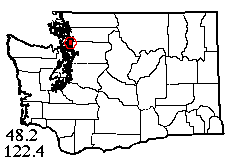 |
![]() 20 IV 2007: Laurel is hooked! She liked her first spider collecting trip
so much, we've had regular outings since. Our second, on a short day (leaving
town mid-morning) was to a relatively close place not easily reached by bus,
which I'd found by investigating its intriguing name: English Boom. It was a
bustling embarkation point for water transport of logs (by the English Lumber
Co.) in the 1920s and 30s, but now is a peaceful salt marsh with scattered pilings
rising out of Skagit Bay; the marsh, beach and some nice woods are an Island
County nature preserve with some public access. See this
page and this
article for more details. The site was easily reached, and we walked east
along the sandy berm (raised outer ridge of the beach).
20 IV 2007: Laurel is hooked! She liked her first spider collecting trip
so much, we've had regular outings since. Our second, on a short day (leaving
town mid-morning) was to a relatively close place not easily reached by bus,
which I'd found by investigating its intriguing name: English Boom. It was a
bustling embarkation point for water transport of logs (by the English Lumber
Co.) in the 1920s and 30s, but now is a peaceful salt marsh with scattered pilings
rising out of Skagit Bay; the marsh, beach and some nice woods are an Island
County nature preserve with some public access. See this
page and this
article for more details. The site was easily reached, and we walked east
along the sandy berm (raised outer ridge of the beach).
The first spider
collected, a speckled lycosid on the sand, was a new state record of Arctosa
perita (see album). Nearly all the other numerous
wolf spiders were the more common Pardosa metlakatla. Sweeping the salt
marsh was only minimally productive at the outer edge, but got better farther
in. Salticus and Micaria were active on the logs. Andrenid bees,
cantharid beetles, and paper wasps were numerous. Returning along the berm,
we scanned all sandy areas carefully, and turned up two females of a habitat-limited
jumping spider, Habronattus ophrys; unfortunately the spectacular males
of this species were not to be found. In the woods above the beach, I sifted
maple litter and got 20 species from this habitat alone! Understory and conifer
foliage were also productive. On the way back to the car I couldn't resist beating
one last fir tree, at the edge of a private yard; and got the rare Trachelas
californicus there! Total, 48 species in about 6 hours!
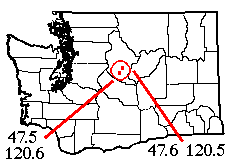 |
![]() 26 IV 2007: On our next trip, threatening weather led Laurel and I to
return to the dry side of the Cascades. I had several incomplete spider samples
from the Leavenworth area, souvenirs of trips with butterfly collectors (who
flit from site to site like a butterfly visiting flowers). To make sure of completing
at least one, we started at an area on Eagle Creek where I already had 13 species:
a valley with wide riparian meadows (farmed, in part) and pine-fir forests interspersed
with steppe habitat on the slopes. The site that looked best was just within
the national forest.
26 IV 2007: On our next trip, threatening weather led Laurel and I to
return to the dry side of the Cascades. I had several incomplete spider samples
from the Leavenworth area, souvenirs of trips with butterfly collectors (who
flit from site to site like a butterfly visiting flowers). To make sure of completing
at least one, we started at an area on Eagle Creek where I already had 13 species:
a valley with wide riparian meadows (farmed, in part) and pine-fir forests interspersed
with steppe habitat on the slopes. The site that looked best was just within
the national forest.
Overcast skies prevented
any spider activity in the meadow, so we proceeded to the cottonwood-alder creekside
woods. There, I sifted litter while Laurel swept understory foliage (mainly
nettles - very potent at this season!) and investigated spiders in aerial webs
and under log bark. The litter fauna included the shield-backed microspider
Pelecopsis and the attractive litter jumping spider Sitticus sylvestris
(see album). Then the sun penetrated the clouds
and wolf spiders started to run! Pardosa mackenziana was in the woods;
P. coloradensis, P. wyuta, Tarentula kochii and the antlike Micaria
were running in the meadow. On the way back to the car, Laurel spotted a cobweb
suspended over an empty small mammal burrow, and I impressed her by digging
up a nice black widow from it. We wrapped up the Eagle Creek sample by beating
some conifer foliage down the road. Laurel is especially interested in flower
crab spiders because of a book she's writing, so we stopped a mile downstream
by a hillside covered with blooming Balsamorhiza. Many of these hosted
lurking immature Misumenops, and one mature male Misumena vatia
was hiding behind a stem (see album).
![]() The rest of the day was devoted to an area south of Leavenworth where I had
only 3 previous species. I'd pre-selected a site on Mill Creek where an intriguing
mountain meadow appeared to be just a little way off the road. Unfortunately
there was no easy way to ascend the steep road cut onto the ridge with the meadow.
However, there were small, scrubby bigleaf maples by the creek (which snow had
only recently left), and some spiders were sifted from the litter. Laurel got
some good records by turning rocks on a steep skid road across a tributary from
the ridge. Several species were beaten from grand fir foliage. Dusk found us
above the road in a small glade (access to the big meadow still eluded us) where
Laurel found a photogenic Cyclosa conica web; its denizen later matured
in the lab making 22 species from this second area. A productive day!
The rest of the day was devoted to an area south of Leavenworth where I had
only 3 previous species. I'd pre-selected a site on Mill Creek where an intriguing
mountain meadow appeared to be just a little way off the road. Unfortunately
there was no easy way to ascend the steep road cut onto the ridge with the meadow.
However, there were small, scrubby bigleaf maples by the creek (which snow had
only recently left), and some spiders were sifted from the litter. Laurel got
some good records by turning rocks on a steep skid road across a tributary from
the ridge. Several species were beaten from grand fir foliage. Dusk found us
above the road in a small glade (access to the big meadow still eluded us) where
Laurel found a photogenic Cyclosa conica web; its denizen later matured
in the lab making 22 species from this second area. A productive day!
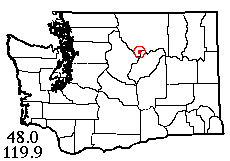 |
![]() 28-9 IV 2007: Since February, I'd been trying to get together with old
caving friend Larry McTigue on a cave-hunting / spider-collecting trip to Okanogan
County. It finally materialized on the first nice weekend of the year. After
a long, long (and expensive) drive we finally crossed into the state's second-largest
county. At Pateros we took a little side trip up the Methow River so I could
supplement a 10-species sample taken at nearby Alta Lake in 1963 by my old friend
Bob Thomson. Hoping for a good leaf litter sample, I precariously picked my
way down a steep gully into the Methow River canyon, but the cottonwood litter
was so dry it yielded only 2 species - both good ones, though. One species was
found under a rock and a nice male Xysticus was "sunning" on
a riverbank boulder - then back up the gully for much more productive collecting
in sagebrush near the car. By a major stroke of luck, the 12 species taken in
2 hours were all different from the 10 prior records, making 22 in all.
28-9 IV 2007: Since February, I'd been trying to get together with old
caving friend Larry McTigue on a cave-hunting / spider-collecting trip to Okanogan
County. It finally materialized on the first nice weekend of the year. After
a long, long (and expensive) drive we finally crossed into the state's second-largest
county. At Pateros we took a little side trip up the Methow River so I could
supplement a 10-species sample taken at nearby Alta Lake in 1963 by my old friend
Bob Thomson. Hoping for a good leaf litter sample, I precariously picked my
way down a steep gully into the Methow River canyon, but the cottonwood litter
was so dry it yielded only 2 species - both good ones, though. One species was
found under a rock and a nice male Xysticus was "sunning" on
a riverbank boulder - then back up the gully for much more productive collecting
in sagebrush near the car. By a major stroke of luck, the 12 species taken in
2 hours were all different from the 10 prior records, making 22 in all.
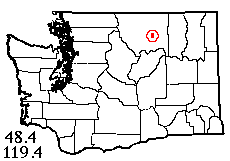 |
![]() On to the next stop! Larry's cave-hunting can sometimes be a little off the
wall. This time he wanted to check out a place shown on maps as Pothole Canyon,
in hopes that the "pothole" would be a cave. I tried to tell him that
it sure didn't look that way on detailed maps and photos; but I was very willing
to go there since I badly needed a spider sample from the area. So we wandered
around intricate, poorly marked, bumpy roads in the foothills of the Okanogan
Highlands, on land that may or may not have been public (certainly no private
signs), for mile after mile. Finally (after passing a mesa that did look like
it might have a small hole or two in it), we arrived at the spot called The
Pothole on the topo map. "Well, here we are. This is the Pothole."
"It ain't much!" So we drove back to the safe side of an open gate
we'd passed, and camped in the ravine of Wanacut Creek which I thought looked
promising, spider-wise.
On to the next stop! Larry's cave-hunting can sometimes be a little off the
wall. This time he wanted to check out a place shown on maps as Pothole Canyon,
in hopes that the "pothole" would be a cave. I tried to tell him that
it sure didn't look that way on detailed maps and photos; but I was very willing
to go there since I badly needed a spider sample from the area. So we wandered
around intricate, poorly marked, bumpy roads in the foothills of the Okanogan
Highlands, on land that may or may not have been public (certainly no private
signs), for mile after mile. Finally (after passing a mesa that did look like
it might have a small hole or two in it), we arrived at the spot called The
Pothole on the topo map. "Well, here we are. This is the Pothole."
"It ain't much!" So we drove back to the safe side of an open gate
we'd passed, and camped in the ravine of Wanacut Creek which I thought looked
promising, spider-wise.
There was about
an hour's worth of daylight which I used sifting aspen litter by my tent-site
(see album) which at 7 species was the best-spidered
litter on the trip. After a somewhat uneasy sleep due to moonlight shining right
into my tent, I got up shortly after dawn to beat conifer foliage, putting several
species into a vial which I promptly lost, and had to re-collect from more conifers!
Fortunately for me, Larry had a nice comfortable bed in his truck and slept
in while I crossed the creek and collected under stones and in sagebrush —
finding an abundance of ticks in the process. Finally the sun emerged enough
to make wolf spiders (Pardosa coloradensis and P. altamontis)
active in the small streamside meadow. A pile of boards and a rotten log produced
additional species for a total of 20.
I next proposed
to Larry that he drop me in a more accessible site back by the Okanogan River
while he went on to the next cave lead, but he preferred to wait while I collected
there. Fortunately the grassy riverside glades were so productive that I got
a sufficient sample in just 1 hour, sweeping the grass, finding diverse aerial
webs, and a few Pardosa xerampelina (see album)
running about to bring the total for the gridspace up to 30. Despite being right
by some railroad tracks (where I wouldn't let cows graze if they were my cows)
there were lots more ticks here too.
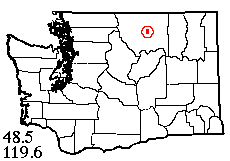 |
![]() After checking out a roadside tunnel (which proved to be artificial and full
of garbage), our last stop for the Okanogan weekend was the saddle east of Cave
Mountain, parking area for well-known Albright Cave. This is a beautiful spot
in the spring, and relatively tick-free. Larry went to rig the cave and check
out a "digging lead" while I collected from young firs and grassy
understory in the forest; willow litter beside Cave Lake; and sagebrush and
rocks in steppe land over the ecotone on the south side of the saddle. Then
I followed Larry back to the cave in search of males of the elusive microspider
Anacornia microps, known in Washington only from this one cave. Three
interesting spider species were taken in cave twilight, and two more in the
lower level, including females of A. microps, but there were plenty of
egg sacs and no males - I was too late again! It's too bad I'd used the last
shot on my camera at the cave entrance: in the lower level, a resident pack
rat (Neotoma cinerea) was suckling 7 young in a dazzling nest that looked
as if it was made of multicolored confetti, but I think was probably flowers!
Satisfied with the day, we obeyed mama rat's annoyed squeaks and ascended back
into just-ending daylight. Back in Seattle at about 2 AM, was I ever glad to
fall into bed!
After checking out a roadside tunnel (which proved to be artificial and full
of garbage), our last stop for the Okanogan weekend was the saddle east of Cave
Mountain, parking area for well-known Albright Cave. This is a beautiful spot
in the spring, and relatively tick-free. Larry went to rig the cave and check
out a "digging lead" while I collected from young firs and grassy
understory in the forest; willow litter beside Cave Lake; and sagebrush and
rocks in steppe land over the ecotone on the south side of the saddle. Then
I followed Larry back to the cave in search of males of the elusive microspider
Anacornia microps, known in Washington only from this one cave. Three
interesting spider species were taken in cave twilight, and two more in the
lower level, including females of A. microps, but there were plenty of
egg sacs and no males - I was too late again! It's too bad I'd used the last
shot on my camera at the cave entrance: in the lower level, a resident pack
rat (Neotoma cinerea) was suckling 7 young in a dazzling nest that looked
as if it was made of multicolored confetti, but I think was probably flowers!
Satisfied with the day, we obeyed mama rat's annoyed squeaks and ascended back
into just-ending daylight. Back in Seattle at about 2 AM, was I ever glad to
fall into bed!
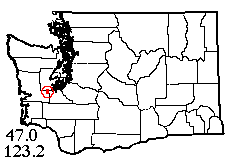 |
![]() 11 V 2007: My next trip with Laurel aimed to complete two partial samples
made on a class field trip way back in 1976, in the Black Hills (Capitol State
Forest) southwest of Olympia. I'd expected this actively working state-income
forest to be alive with the sound of chain saws and log trucks, but on this
weekday visit we saw and heard almost no one. Our first stop was a riparian
forest and small wetland on Bozy Creek, not far from a circa-1989 clearcut (see
album). Though not pristine, the site was very attractive and perhaps the
most delightfully peaceful place I've visited since I was last in the Kuril
Islands in 1997! Spider collecting here wasn't outstanding, but each of
the habitats sampled produced several species, including understory foliage,
aerial webs (which included some very large Tetragnatha webs over the
creek), stream banks and gravel bar, alder/shrub litter, grassy roadside verge,
and conifer foliage. Moss on dead limbs was especially productive with 9 species
taken. Even though some species duplicated the prior records, we still boosted
the sample up to 25. Laurel found 2 male Misumena vatia to photograph
for her project, and one of them attempted to balloon off my finger (see
album.)
11 V 2007: My next trip with Laurel aimed to complete two partial samples
made on a class field trip way back in 1976, in the Black Hills (Capitol State
Forest) southwest of Olympia. I'd expected this actively working state-income
forest to be alive with the sound of chain saws and log trucks, but on this
weekday visit we saw and heard almost no one. Our first stop was a riparian
forest and small wetland on Bozy Creek, not far from a circa-1989 clearcut (see
album). Though not pristine, the site was very attractive and perhaps the
most delightfully peaceful place I've visited since I was last in the Kuril
Islands in 1997! Spider collecting here wasn't outstanding, but each of
the habitats sampled produced several species, including understory foliage,
aerial webs (which included some very large Tetragnatha webs over the
creek), stream banks and gravel bar, alder/shrub litter, grassy roadside verge,
and conifer foliage. Moss on dead limbs was especially productive with 9 species
taken. Even though some species duplicated the prior records, we still boosted
the sample up to 25. Laurel found 2 male Misumena vatia to photograph
for her project, and one of them attempted to balloon off my finger (see
album.)
 |
![]() Our chosen site for the second half of the day was farther east at the McLane
Creek Nature Trail, a Department of Natural Resources interpretive preserve
with floodplain forest (chiefly bigleaf maple), large beaver ponds, and some
tall grassland. Non-native species are present, but the nastier invasives are
not dominant except in a few spots. We first hiked about half the network of
nature trails (some of them under repair after last fall's storm damage) to
scope out habitats, then set up in an off-trail tall grass area on the south
edge of the preserve. No wolf spiders were active because the whole area was
in the shade of nearby Rock Candy Mountain. I got several species from maple
litter, but could have saved my time spent sifting moss — it only added
one species. Laurel found a great crab spider "photo op" on an isolated
apple tree in bloom, where three male Misumena were "guarding"
a female preparing to molt to maturity in a curled leaf (see
album). Later, she helped out by intrepidly braving the nettles and blackberries
to beat the foliage of the one cedar tree in the vicinity, and also got an unusual
small Antrodiaetus burrowing in a stump left from the old-growth days.
With dusk approaching, I wanted to try one more habitat and luckily decided
on sifting grass litter, which was so productive it was hard to drag me away
— 9 species including 2 unfamiliar microspiders. This half-day visit alone
got us 26 species from the site, making 34 with the prior sample. Our last official
act was to photograph an unintentionally amusing DNR interpretive sign. All
in all, a wonderful day.
Our chosen site for the second half of the day was farther east at the McLane
Creek Nature Trail, a Department of Natural Resources interpretive preserve
with floodplain forest (chiefly bigleaf maple), large beaver ponds, and some
tall grassland. Non-native species are present, but the nastier invasives are
not dominant except in a few spots. We first hiked about half the network of
nature trails (some of them under repair after last fall's storm damage) to
scope out habitats, then set up in an off-trail tall grass area on the south
edge of the preserve. No wolf spiders were active because the whole area was
in the shade of nearby Rock Candy Mountain. I got several species from maple
litter, but could have saved my time spent sifting moss — it only added
one species. Laurel found a great crab spider "photo op" on an isolated
apple tree in bloom, where three male Misumena were "guarding"
a female preparing to molt to maturity in a curled leaf (see
album). Later, she helped out by intrepidly braving the nettles and blackberries
to beat the foliage of the one cedar tree in the vicinity, and also got an unusual
small Antrodiaetus burrowing in a stump left from the old-growth days.
With dusk approaching, I wanted to try one more habitat and luckily decided
on sifting grass litter, which was so productive it was hard to drag me away
— 9 species including 2 unfamiliar microspiders. This half-day visit alone
got us 26 species from the site, making 34 with the prior sample. Our last official
act was to photograph an unintentionally amusing DNR interpretive sign. All
in all, a wonderful day.
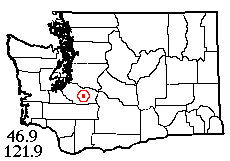 |
![]() 17 V 2007: Wanting to upgrade an old 4-species sample from the Carbon
River area just west of Mt. Rainier National Park, I'd selected what looked
like a nice semi-wetland mountain meadow up Tolmie Creek. To reach the site,
Laurel and I drove up a steep, unfrequented forest road, then hiked a further
mile and a half up a jeep trail too rough for her car. The trail crossed the
creek on a half-washed-out bridge at the top of what looked like a mighty impressive
waterfall, then switched back across again just below the "meadow"
— which turned out to be a classic swamp (forested wetland, with alder,
cedar and even some hemlock growing from the water among the skunk cabbage),
beautiful but impenetrable by us. Alder litter, moss, logs and aerial webs at
the swamp edge did produce some interesting species, most notably the primitive
relict Microhexura idahoana, first record from that side of Mt. Rainier.
Halfway back to the car, a rock talus field proved very rich in spiders, but
mostly immature except for a lot of Bathyphantes alascensis; conifer
foliage there was moderately productive.
17 V 2007: Wanting to upgrade an old 4-species sample from the Carbon
River area just west of Mt. Rainier National Park, I'd selected what looked
like a nice semi-wetland mountain meadow up Tolmie Creek. To reach the site,
Laurel and I drove up a steep, unfrequented forest road, then hiked a further
mile and a half up a jeep trail too rough for her car. The trail crossed the
creek on a half-washed-out bridge at the top of what looked like a mighty impressive
waterfall, then switched back across again just below the "meadow"
— which turned out to be a classic swamp (forested wetland, with alder,
cedar and even some hemlock growing from the water among the skunk cabbage),
beautiful but impenetrable by us. Alder litter, moss, logs and aerial webs at
the swamp edge did produce some interesting species, most notably the primitive
relict Microhexura idahoana, first record from that side of Mt. Rainier.
Halfway back to the car, a rock talus field proved very rich in spiders, but
mostly immature except for a lot of Bathyphantes alascensis; conifer
foliage there was moderately productive.
But we still didn't
have enough species, and had found no meadow habitat for Laurel's flower-spider
project. So we cruised around for a while down on the Carbon River road trying
to get access to elusive riparian meadows, and finally settled on an artificial
gravel-supply platform left by road builders, fringed by tall grass, buttercups
and maples. This spot was surprisingly productive. I added 11 species to the
day's take, and 4 or 5 different immature instars of the flower crab spider
Misumena vatia kept Laurel happily posing them on buttercups until it
got too dark for photography.
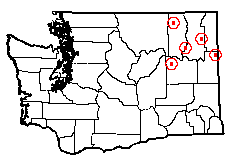 |
26-28 V 2007: All year, Larry McTigue and I had been planning a giant
Memorial Day weekend eastern-Washington expedition, with me hunting spiders
and Larry hunting caves. Saturday morning, the forecast suggested a 50% chance
of thunderstorms on Sunday, but was that enough to make us cancel? Of course
not! We headed north from I-90 via the town of Wilbur, where my friends the
Stoothoffs had collected 18 spider species from their house and yard in 1991.
Half an hour at a good "wild" site SW of town sufficed to bring the
sample up to 22 species; a lovely spot too, with many flowers blooming amid
the sagebrush. You'd expect a gas station in a town of 1400 people, right? We
found three in Wilbur — all out of business!
Then on to our first
official stop, the town of Hunters on the Columbia at the west edge of Stevens
County. The area where I'd collected 7 species here in 1974 is now inaccessible,
but some driving around led us to a strip of meadow and pines at the edge of
public and private land along the road down to Hunters Campground, where I collected
while Larry looked for the many limestone deposits in the area. I'd chosen well
— the meadow foliage, pine foliage and Ribes shrubs at the edge
of the clearing each produced a number of species, and a Bassaniana crab
spider from pine bark brought me up to 20 species in just a couple of hours,
making 26 with the old records. One jumping spider from the pines was completely
unfamiliar. Larry returned, having seen few outcrops and no caves in the alleged
limestone areas, and just at dusk we lucked into quite a nice campsite along
a private logging road above the highway.
![]() The moon was out when I went to sleep, but just at sunrise I heard raindrops
patter on my tent! It didn't last long, but long enough to make vegetation too
wet for beating. But the sun came out, we got up and headed for one of Larry's
major goals, Limestone Spring northeast of Chewelah, a name that practically
shouted "caves here!" but required a long, circuitous drive on logging
roads to reach. For collecting, I'd selected Johnson Lake on the ridge above
the spring, a tiny secluded water body encircled by marsh meadow. The lake was
another beautiful spot, with nary a sign of human activity, but I had to mark
time collecting from unproductive alder litter and other peripheral habitats
while the sun dried out the meadow grass from the dawn rain. Finally I was able
to sweep on at least one side of the lake, and got a number of species; a mule
deer joined me for a little grazing while I was chasing wolf spiders. Some species
were added from conifer foliage, but I still didn't have quite enough when Larry
returned, having finally found the "spring," really a seep, and no
limestone outcrop anywhere around it (the limestone it's named for is some distance
off). Fortunately, conifer litter back in the forest added just barely enough
species to make a sample, including one unfamiliar linyphiid microspider.
The moon was out when I went to sleep, but just at sunrise I heard raindrops
patter on my tent! It didn't last long, but long enough to make vegetation too
wet for beating. But the sun came out, we got up and headed for one of Larry's
major goals, Limestone Spring northeast of Chewelah, a name that practically
shouted "caves here!" but required a long, circuitous drive on logging
roads to reach. For collecting, I'd selected Johnson Lake on the ridge above
the spring, a tiny secluded water body encircled by marsh meadow. The lake was
another beautiful spot, with nary a sign of human activity, but I had to mark
time collecting from unproductive alder litter and other peripheral habitats
while the sun dried out the meadow grass from the dawn rain. Finally I was able
to sweep on at least one side of the lake, and got a number of species; a mule
deer joined me for a little grazing while I was chasing wolf spiders. Some species
were added from conifer foliage, but I still didn't have quite enough when Larry
returned, having finally found the "spring," really a seep, and no
limestone outcrop anywhere around it (the limestone it's named for is some distance
off). Fortunately, conifer litter back in the forest added just barely enough
species to make a sample, including one unfamiliar linyphiid microspider.
The early afternoon
weather seemed lovely, so we headed north to a known cave on private land near
Addy. Within minutes, the threatened thunderstorms had appeared, and Larry was
getting rained on while talking to the cave owner and being denied permission
to enter — it seems the ashes of her late husband, whom I'd met in 1979,
were now in the cave! So, scratch that! Let's go look for reported sinkholes
on Rabbit Mountain, still farther north. Big rainclouds continued to appear,
and the road around the base of the mountain was a succession of huge puddles.
Eventually we tracked down the road up to the ridge crest, which we'd no sooner
reached when we encountered a man cutting firewood from a downed tree in the
middle of the road. "Oh, this road just ends in a hundred yards, you might
as well stop here." After waiting in a byway while the wet woodcutter cleared
out, we continued more than a mile — he'd been lying, and right in front
of his daughter too! But the woods were so thick, we couldn't have found a sinkhole
except by falling into it, and the rain had settled into a steady downpour.
Finally, even Larry had to give up. We tossed a virtual coin on whether to go
west or south to escape the rain. South won, but everything still looked wet
even as far south as Deer Park. Just at dusk, we camped in a ridge crest clearcut
(with houses nearby) near a mysterious locality called "Hells Hole,"
on wet ground but under a clear sky.
After midnight,
an increasingly cold wind came up, and daybreak of May 28 felt more like winter!
Unwrapping myself from the layers added during the night, I luckily managed
to get my tent packed and a 7-species sample taken (to supplement 19 from a
nearby pitfall study) before rain resumed. By the time I was securely ensconced
in the truck, the rain was mixed with sleet. So much for a sunny, warm late
spring trip. Larry was very receptive to the idea of moving into the central
Washington desert, where I offered to guide him to Dry Falls Cave. We reached
the Dry Falls overlook without incident, strolled over to the trail down to
the cave: big steel bar across with "Trail Closed" sign! So, with
possibly 10 hours of daylight left in our big trip, and the rain clouds trailing
off eastward, we decided to have one more try at limestone country to the north
— this time in Ferry County. A stop at Lime Creek (tributary of the Sanpoil
River) looked promising for spiders, but I only got 4 species while Larry determined
there was no rock outcrop in sight. Next, to a known marble deposit at the summit
of Sheep Mountain — an area where I already had a good sample. There actually
was some rock visible at the summit, but nothing looked karstic.
![]() Finally, I wanted to at least get a spider sample from an area along the east
side of Curlew Lake where I and Jon Pelham had taken 11 species under rocks
on a wet day in 1974. It was getting late, so we stopped at the first likely
spot, a grassy clearing on Wolfe Camp Road with seral forest around. The clearing
was newer than I suspected: a 1998 aerial photo shows a building on the site.
The grass only produced 3 species, but conifer foliage and especially shrub
foliage were very productive, and I got 16 species (including about 5 Dictyna)
in a hour or so, making 27 total. Heading for home, we arrived in Okanogan County
just before sunset and indulged in one last wild-cave chase in the face of rapidly
overtaking darkness. Upshot of the trip: I got 5 valuable small spider samples,
4 of them supplementing previous incomplete collections, but never had a chance
to get the big samples from outstanding habitats that I'd dreamed of. But Larry
fared worse, with no caves at all (unless you count a roadside rockshelter we
looked into on the way north from Dry Falls), and in many cases not even a limestone
outcrop! Oh well, the best-laid plans of cavers and arachnologists...
Finally, I wanted to at least get a spider sample from an area along the east
side of Curlew Lake where I and Jon Pelham had taken 11 species under rocks
on a wet day in 1974. It was getting late, so we stopped at the first likely
spot, a grassy clearing on Wolfe Camp Road with seral forest around. The clearing
was newer than I suspected: a 1998 aerial photo shows a building on the site.
The grass only produced 3 species, but conifer foliage and especially shrub
foliage were very productive, and I got 16 species (including about 5 Dictyna)
in a hour or so, making 27 total. Heading for home, we arrived in Okanogan County
just before sunset and indulged in one last wild-cave chase in the face of rapidly
overtaking darkness. Upshot of the trip: I got 5 valuable small spider samples,
4 of them supplementing previous incomplete collections, but never had a chance
to get the big samples from outstanding habitats that I'd dreamed of. But Larry
fared worse, with no caves at all (unless you count a roadside rockshelter we
looked into on the way north from Dry Falls), and in many cases not even a limestone
outcrop! Oh well, the best-laid plans of cavers and arachnologists...
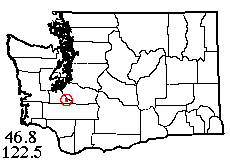 |
![]() 7 VI 2007: All western Washington naturalists are interested in the gravelly
prairies (some mounded, some not) at the south end of Puget Sound for their
distinctive flora and fauna. When the pioneers arrived, these covered very large
areas, but most are now altered or overgrown. Smith Prairie in eastern Thurston
County had no natural remnants known to me, but I spotted a possibility on satellite
photos and went with Laurel to check it out. Glad I did! Although not pristine
(much of the short grass replaced with taller species), the area we found is
otherwise in great condition, with very little blackberry or broom. It has big
scattered ash trees, and a big adjacent marsh. The surroundings were logged
recently but a fringe of forest around the meadows was left intact, mirabile
dictu. The first 12 species were taken by sweeping grass, the next 16 from
beating fir foliage. I stood in a mysterious deep hole under an ash tree and
sifted litter for 8 more. Laurel took the best species of the day on old fence
posts, jumping spider Tutelina similis, last seen in these parts in 1895!!
We moved north through a fine fir forest to a higher quality prairie remnant
north of the highway, where Laurel took a mature male of the undescribed Aculepeira
orbweaver common to all these prairies. Total, 47 species in about 6 hours.
We ended a great day by scouting a future collecting site on the Nisqually River
at McKenna.
7 VI 2007: All western Washington naturalists are interested in the gravelly
prairies (some mounded, some not) at the south end of Puget Sound for their
distinctive flora and fauna. When the pioneers arrived, these covered very large
areas, but most are now altered or overgrown. Smith Prairie in eastern Thurston
County had no natural remnants known to me, but I spotted a possibility on satellite
photos and went with Laurel to check it out. Glad I did! Although not pristine
(much of the short grass replaced with taller species), the area we found is
otherwise in great condition, with very little blackberry or broom. It has big
scattered ash trees, and a big adjacent marsh. The surroundings were logged
recently but a fringe of forest around the meadows was left intact, mirabile
dictu. The first 12 species were taken by sweeping grass, the next 16 from
beating fir foliage. I stood in a mysterious deep hole under an ash tree and
sifted litter for 8 more. Laurel took the best species of the day on old fence
posts, jumping spider Tutelina similis, last seen in these parts in 1895!!
We moved north through a fine fir forest to a higher quality prairie remnant
north of the highway, where Laurel took a mature male of the undescribed Aculepeira
orbweaver common to all these prairies. Total, 47 species in about 6 hours.
We ended a great day by scouting a future collecting site on the Nisqually River
at McKenna.
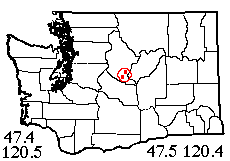 |
![]() 12 VI 2007: Today's goal was a place that's intrigued me for years, "Camas
Land," a large mountain meadow in the Wenatchee Mountains not far south
of Cashmere. In the past, much of this grassland has been farmed, but I thought
I could discern some still-natural bits on aerial photos. I had no idea that
a large and increasing part has been made a state Natural Area Preserve. Having
no NAP permit this year, Laurel and I collected in an equally good bit on state
and private land just outside the preserve. Unlike the previous week's Smith
Prairie site, the meadows here aren't grass-dominated; almost every square foot
exemplifies floristic diversity. Thirteen spider species were swept from the
meadow, including an especially beautiful flower spider I dubbed "Miss
Camas Land of 2007." Laurel sampled pine and fir foliage for quite a few
more. The most interesting spiders of the trip were from litter of what turned
out to be native hawthorn, not something you see often in the Cascades. I finally
located some late wolf spiders in a wet part of the meadow, and other habitats
brought us to 27 species, or 41 with prior records from the area. We also had
a cordial conversation with one of the landowners.
12 VI 2007: Today's goal was a place that's intrigued me for years, "Camas
Land," a large mountain meadow in the Wenatchee Mountains not far south
of Cashmere. In the past, much of this grassland has been farmed, but I thought
I could discern some still-natural bits on aerial photos. I had no idea that
a large and increasing part has been made a state Natural Area Preserve. Having
no NAP permit this year, Laurel and I collected in an equally good bit on state
and private land just outside the preserve. Unlike the previous week's Smith
Prairie site, the meadows here aren't grass-dominated; almost every square foot
exemplifies floristic diversity. Thirteen spider species were swept from the
meadow, including an especially beautiful flower spider I dubbed "Miss
Camas Land of 2007." Laurel sampled pine and fir foliage for quite a few
more. The most interesting spiders of the trip were from litter of what turned
out to be native hawthorn, not something you see often in the Cascades. I finally
located some late wolf spiders in a wet part of the meadow, and other habitats
brought us to 27 species, or 41 with prior records from the area. We also had
a cordial conversation with one of the landowners.
![]() Way back in 1974 I'd been to Nahahum Canyon north of Cashmere with Jon Pelham,
but he was ready to move on when I was just getting started. So now we devoted
the last hours of daylight to bringing the old 9-species sample up to 21, which
we managed, in the next canyon to the west, Hay Canyon. Summer dryness was taking
its toll on the spiders here, but some (and the most interesting ones) were
still in bigleaf maple litter on the canyon bottom. I spotted a mature Oxyopes
lynx spider doing a crab-spider act on a pearly-everlasting flower; she dodged
under the flower the moment she saw me coming! Laurel got several species from
a white-flowered shrub high on the canyon side, and more were taken from fir
foliage. A local man who'd driven up the canyon to service outhouses stopped
to chat, and after he fully realized what I was doing, head-shakingly proclaimed
"Heck of a hobby!"
Way back in 1974 I'd been to Nahahum Canyon north of Cashmere with Jon Pelham,
but he was ready to move on when I was just getting started. So now we devoted
the last hours of daylight to bringing the old 9-species sample up to 21, which
we managed, in the next canyon to the west, Hay Canyon. Summer dryness was taking
its toll on the spiders here, but some (and the most interesting ones) were
still in bigleaf maple litter on the canyon bottom. I spotted a mature Oxyopes
lynx spider doing a crab-spider act on a pearly-everlasting flower; she dodged
under the flower the moment she saw me coming! Laurel got several species from
a white-flowered shrub high on the canyon side, and more were taken from fir
foliage. A local man who'd driven up the canyon to service outhouses stopped
to chat, and after he fully realized what I was doing, head-shakingly proclaimed
"Heck of a hobby!"
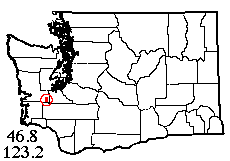 |
![]() 20 VI 2007: Scarab Pyle had recently
(May 25) discovered a remnant of high-quality gravelly prairie sandwiched among
farmland on the west side of the Chehalis River valley, well west of other such
sites; Laurel and I had just time to visit it before lowland collecting season
started to wind down. At first I could find no name for the site and was tempted
to call it Pyle's Prairie, but I finally found the name Ford Prairie had been
used in a once-similar area only about a mile to the north. Confusingly, there
is also a Ford's Prairie far to the southeast in Lewis County. In any case,
the weatherman was wrong and we had a beautiful sunny day to sweep the grass,
herbs and flowers. The sweeping, plus a row of 5 pitfall traps, produced 20
species including a number of prairie-limited rarities: Tricholathys rothi,
Aculepeira sp., Metepeira grandiosa (rare indeed in this region),
a jumping spider not yet identified, Pardosa distincta, and best of all
Pardosa ramulosa — which is alleged not to occur north of California!
— together with its common sibling P. vancouveri, showing conclusively
the two are distinct here.
20 VI 2007: Scarab Pyle had recently
(May 25) discovered a remnant of high-quality gravelly prairie sandwiched among
farmland on the west side of the Chehalis River valley, well west of other such
sites; Laurel and I had just time to visit it before lowland collecting season
started to wind down. At first I could find no name for the site and was tempted
to call it Pyle's Prairie, but I finally found the name Ford Prairie had been
used in a once-similar area only about a mile to the north. Confusingly, there
is also a Ford's Prairie far to the southeast in Lewis County. In any case,
the weatherman was wrong and we had a beautiful sunny day to sweep the grass,
herbs and flowers. The sweeping, plus a row of 5 pitfall traps, produced 20
species including a number of prairie-limited rarities: Tricholathys rothi,
Aculepeira sp., Metepeira grandiosa (rare indeed in this region),
a jumping spider not yet identified, Pardosa distincta, and best of all
Pardosa ramulosa — which is alleged not to occur north of California!
— together with its common sibling P. vancouveri, showing conclusively
the two are distinct here.
![]() Returning to the car, we noticed a sizable oak grove right across the road from
the little valley with the high quality grassland. The grove was not such high
quality, though; invaded by ivy and Himalayan blackberry, with a higher proportion
of non-native spiders, and no real spider rarities. But the litter, oak foliage
and moss did add 10 species to our list. Just one km south of this oak grove
is an old gravel pit supporting a pocket forest of conifers, alder and cottonwood,
below the general land level and thus closer to the water table. Despite the
obnoxious presence of Himalayan blackberry, this habitat boosted our day's take
over 40 species. As a final touch, I wanted to search the banks of the Chehalis
River itself for Pardosa californica, whose only Washington record
is from along this river some miles to the south. I did get Pardosa there
but it was only P. vancouveri; had an interesting conversation, though,
with a couple of salmon fishermen from the nearby Chehalis Reservation.
Returning to the car, we noticed a sizable oak grove right across the road from
the little valley with the high quality grassland. The grove was not such high
quality, though; invaded by ivy and Himalayan blackberry, with a higher proportion
of non-native spiders, and no real spider rarities. But the litter, oak foliage
and moss did add 10 species to our list. Just one km south of this oak grove
is an old gravel pit supporting a pocket forest of conifers, alder and cottonwood,
below the general land level and thus closer to the water table. Despite the
obnoxious presence of Himalayan blackberry, this habitat boosted our day's take
over 40 species. As a final touch, I wanted to search the banks of the Chehalis
River itself for Pardosa californica, whose only Washington record
is from along this river some miles to the south. I did get Pardosa there
but it was only P. vancouveri; had an interesting conversation, though,
with a couple of salmon fishermen from the nearby Chehalis Reservation.
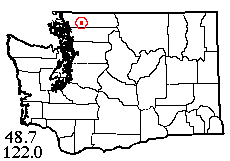 |
![]() 2 VII 2007: It was summer now, and seeking mid-elevation collecting sites
I found Dailey Prairie in a list of Whatcom County "flats." Seeking
more info, I was surprised to learn from this
page that the site was a state Natural Area Preserve. I applied to the state
office for collecting permission, which was soon granted, and David Wilderman
in Olympia referred me to Christ Thomsen (his real name) in the Sedro Woolley
office for a key to the gated roads into the area. Monday morning, final arrangements
were made through Laurel's mobile phone as we were heading north. Everything
went smoothly until we tried to drive in the way I'd planned instead of the
way Christ recommended. We quickly ran out of road, and after a stop for gas
in Acme, we tried again from the Mosquito Lake side, on unfamiliar roads that
proved easy enough to navigate with the DNR district map. Soon we were at our
destination, a large, beautiful, flowery, meadow-like montane bog with Twin
Sisters Mountain looming to the east. The one factor making the spot less than
idyllic was a very large mosquito population. I sifted Sphagnum (getting
surprisingly few species) while Laurel swept; I later joined her and our joint
sweep sample included 17 of the eventual 35 species. The adjacent old growth
forest was a very thin fringe buffering the bog from adjacent clearcuts, but
was a fascinating mix of Alaska yellow cedar, mountain hemlock and true firs;
the conifer foliage was productive as usual. Bog laurel foliage (sampled by
Laurel), pitfall traps, and assorted minor habitats all contributed. The most
interesting species was the orbweaver Larinioides cornutus, which in
Washington had been taken only on salt water beaches before. As usual with state
Natural Area Preserves, it was a great spot, with good spiders, fascinating
flora and magnificent scenery.
2 VII 2007: It was summer now, and seeking mid-elevation collecting sites
I found Dailey Prairie in a list of Whatcom County "flats." Seeking
more info, I was surprised to learn from this
page that the site was a state Natural Area Preserve. I applied to the state
office for collecting permission, which was soon granted, and David Wilderman
in Olympia referred me to Christ Thomsen (his real name) in the Sedro Woolley
office for a key to the gated roads into the area. Monday morning, final arrangements
were made through Laurel's mobile phone as we were heading north. Everything
went smoothly until we tried to drive in the way I'd planned instead of the
way Christ recommended. We quickly ran out of road, and after a stop for gas
in Acme, we tried again from the Mosquito Lake side, on unfamiliar roads that
proved easy enough to navigate with the DNR district map. Soon we were at our
destination, a large, beautiful, flowery, meadow-like montane bog with Twin
Sisters Mountain looming to the east. The one factor making the spot less than
idyllic was a very large mosquito population. I sifted Sphagnum (getting
surprisingly few species) while Laurel swept; I later joined her and our joint
sweep sample included 17 of the eventual 35 species. The adjacent old growth
forest was a very thin fringe buffering the bog from adjacent clearcuts, but
was a fascinating mix of Alaska yellow cedar, mountain hemlock and true firs;
the conifer foliage was productive as usual. Bog laurel foliage (sampled by
Laurel), pitfall traps, and assorted minor habitats all contributed. The most
interesting species was the orbweaver Larinioides cornutus, which in
Washington had been taken only on salt water beaches before. As usual with state
Natural Area Preserves, it was a great spot, with good spiders, fascinating
flora and magnificent scenery.
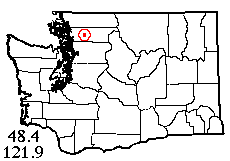 |
![]() 11 VII 2007: A mountain range extending west from the Cascades south
of the Skagit River, known as the Cultus ("worthless" in Chinook jargon)
Mountains, was undersampled for spiders. I spotted a very promising site on
aerial photos of Coal Mountain, with a meadow (probably a bog) surrounding a
pond, a road leading up to summit forests, and a little outlying peak or "inselberg"
surrounded by cliffs and talus. Laurel and I reached the site with little difficulty
and sure enough, it was a Sphagnum bog. So I spent considerable time
sifting Sphagnum, but as it turned out, most of the microspiders taken
were immature and only one could be identified. Sweeping the bog meadow, Laurel
and I took only 11 species (one being an unfamiliar Ceraticelus, best
specimen of the day, and one being the first montane specimen of recently introduced
Xysticus cristatus). Conifer foliage produced only one species that didn't
duplicate the sweep sample, pitfalls in the bog yielded 2 lycosid species, and
conifer litter produced nothing mature. All this time, we were donating blood
to the fly families Rhagionidae, Tabanidae, Culicidae and Simuliidae. Two additional
spider species were taken back by the road, which was blocked, preventing us
from going higher than about 3400 feet.
11 VII 2007: A mountain range extending west from the Cascades south
of the Skagit River, known as the Cultus ("worthless" in Chinook jargon)
Mountains, was undersampled for spiders. I spotted a very promising site on
aerial photos of Coal Mountain, with a meadow (probably a bog) surrounding a
pond, a road leading up to summit forests, and a little outlying peak or "inselberg"
surrounded by cliffs and talus. Laurel and I reached the site with little difficulty
and sure enough, it was a Sphagnum bog. So I spent considerable time
sifting Sphagnum, but as it turned out, most of the microspiders taken
were immature and only one could be identified. Sweeping the bog meadow, Laurel
and I took only 11 species (one being an unfamiliar Ceraticelus, best
specimen of the day, and one being the first montane specimen of recently introduced
Xysticus cristatus). Conifer foliage produced only one species that didn't
duplicate the sweep sample, pitfalls in the bog yielded 2 lycosid species, and
conifer litter produced nothing mature. All this time, we were donating blood
to the fly families Rhagionidae, Tabanidae, Culicidae and Simuliidae. Two additional
spider species were taken back by the road, which was blocked, preventing us
from going higher than about 3400 feet.
I hoped to supplement
the bog spiders with under-stone fauna from the nearby talus. We couldn't figure
out how to reach the talus south of the inselberg, but the boulder areas on
the north side were just a matter of crossing a narrow clearcut – which
was a painful maze of tangled woody shrubs, sharp slash branches, and deep holes
hidden in vegetation. But I finally made it to the rocks, and found only one
additional species there. Meanwhile, Laurel was sweeping in a second, non-bog
meadow, where the 6 species taken all duplicated those from the bog. Result
of all that work in this very beautiful site (see album),
a suboptimal sample of 20 species. Bad luck? Poor judgment? Lateness of the
season? Or some other reason – who knows?
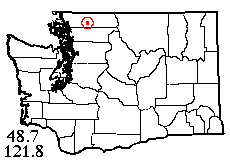 |
![]() 14 VII 2007: It was a dual-purpose trip. Laurel, with her friend Marie
Rose and my friend Della, were going to soak in Baker Hot Spring while I alone
was deposited at the Park Butte trailhead to hike in to Schriebers Meadow, south
of Mount Baker at 3500 feet. The hike was short and pleasant, and once in the
heart of the meadow area, I left the fairly busy trail and set up for collecting
a quarter mile to the south, where I neither heard nor saw a human all day.
This meadow is far from uniform, but is a patchwork of grassy-flowery places,
little wetlands, shrub/heather areas, and tree clumps. The latter limit medium-range
visibility (though one can always see Mt. Baker and other nearby heights), so
I had to use my compass, flagging, and landmark recognition skills if I ever
hoped to return to where I'd left my backpack and set my pitfall traps! Sweeping
in the three varieties of meadow produced 9 spider species, with conifer foliage
adding only 3 more. A short distance to the west was Rocky Creek, where I found
3 species under stones along a small tributary whose orange-stained bed (probably
ferrous hydroxide) resembles streams polluted by acid mine drainage, though
I know of no mines near here. No such deposit was seen on the vast stream-cobble
floodplain of Rocky Creek itself, where I found a wolf spider remarkably like
the early spring Pardosa lowriei. Whilst sitting on a log in the woods
writing labels, I spotted a doe edging into an adjacent glade. The click of
my camera made her leap away like the deer on a highway deer-crossing sign!
Despite my poor results with Sphagnum the previous week, I tried sifting
a little patch of the stuff found under some shrubs, and was surprised to get
3 mature species, including an unfamiliar Agyneta. The pitfalls produced
3 more wolf spider species and a Micaria, for a total of 22 before I
was due to head out (leaving the mosquitos in possession). No doubt there is
some season when one could get a richer sample here, but what I got today was
worthwhile.
14 VII 2007: It was a dual-purpose trip. Laurel, with her friend Marie
Rose and my friend Della, were going to soak in Baker Hot Spring while I alone
was deposited at the Park Butte trailhead to hike in to Schriebers Meadow, south
of Mount Baker at 3500 feet. The hike was short and pleasant, and once in the
heart of the meadow area, I left the fairly busy trail and set up for collecting
a quarter mile to the south, where I neither heard nor saw a human all day.
This meadow is far from uniform, but is a patchwork of grassy-flowery places,
little wetlands, shrub/heather areas, and tree clumps. The latter limit medium-range
visibility (though one can always see Mt. Baker and other nearby heights), so
I had to use my compass, flagging, and landmark recognition skills if I ever
hoped to return to where I'd left my backpack and set my pitfall traps! Sweeping
in the three varieties of meadow produced 9 spider species, with conifer foliage
adding only 3 more. A short distance to the west was Rocky Creek, where I found
3 species under stones along a small tributary whose orange-stained bed (probably
ferrous hydroxide) resembles streams polluted by acid mine drainage, though
I know of no mines near here. No such deposit was seen on the vast stream-cobble
floodplain of Rocky Creek itself, where I found a wolf spider remarkably like
the early spring Pardosa lowriei. Whilst sitting on a log in the woods
writing labels, I spotted a doe edging into an adjacent glade. The click of
my camera made her leap away like the deer on a highway deer-crossing sign!
Despite my poor results with Sphagnum the previous week, I tried sifting
a little patch of the stuff found under some shrubs, and was surprised to get
3 mature species, including an unfamiliar Agyneta. The pitfalls produced
3 more wolf spider species and a Micaria, for a total of 22 before I
was due to head out (leaving the mosquitos in possession). No doubt there is
some season when one could get a richer sample here, but what I got today was
worthwhile.
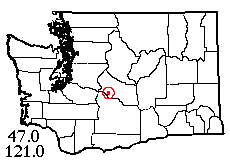 |
![]() 26 VII 2007: Back in 1990, a typical
butterfly trip (6 localities in 6 hours!) produced only 13 spider species from
Quartz Mountain, one of the few places in this state where you can drive to
an elevation over 6000 feet. Despite the late season, Laurel and I were confident
of supplementing that good head start with this year's visit. Our first stop
was Taneum Lake, a secluded, round mountain lake at 5270' reached by a short,
easy trail mostly through forest. The conifer foliage habitat was rich in spiders,
and while I was sifting conifer litter (for 3 species), a Cybaeus exlineae
(new state record) happened to stroll by. Laurel came up with the first adult
Araneus orbweaver of the season, and a few more species from understory
and the very narrow riparian zone. On the way out, we passed the only humans
we saw all day and stopped at a small but very rich meadow (see
album).
26 VII 2007: Back in 1990, a typical
butterfly trip (6 localities in 6 hours!) produced only 13 spider species from
Quartz Mountain, one of the few places in this state where you can drive to
an elevation over 6000 feet. Despite the late season, Laurel and I were confident
of supplementing that good head start with this year's visit. Our first stop
was Taneum Lake, a secluded, round mountain lake at 5270' reached by a short,
easy trail mostly through forest. The conifer foliage habitat was rich in spiders,
and while I was sifting conifer litter (for 3 species), a Cybaeus exlineae
(new state record) happened to stroll by. Laurel came up with the first adult
Araneus orbweaver of the season, and a few more species from understory
and the very narrow riparian zone. On the way out, we passed the only humans
we saw all day and stopped at a small but very rich meadow (see
album).
![]() We still had hours of daylight left, and headed on up the road toward Hereford
Meadow (5800' at upper end). In the process of trying 2 wrong access roads,
we found an unofficial campsite whose home-made outhouse was decorated with
some of the most scurrilous graffiti I've ever seen, but had 2 Pimoa curvata
inside. Finally at the meadow (seasonally occupied by prospectors but in great
condition habitat-wise), we found that sweeping produced several species not
found at the lake, with Aculepeira packardi abundant. The forest edge
was an unusual combination of subalpine fir, Engelmann spruce and whitebark
pine. The outside walls of the miners' intact cabins were spider-free, but Laurel
found one shed that had collapsed, with Orodrassus, Zelotes and Schizocosa
under the boards, while the low-angled sun glinting off a web led me to a fine
Steatoda albomaculata. The mosquitos were just getting started when we
headed for home. My pitfalls near the lake trailhead had been unproductive,
but we still got 31 species - 37 with the prior records. A coyote and deer crossing
the road added interest to the trip out; the sun was just setting as we approached
the freeway.
We still had hours of daylight left, and headed on up the road toward Hereford
Meadow (5800' at upper end). In the process of trying 2 wrong access roads,
we found an unofficial campsite whose home-made outhouse was decorated with
some of the most scurrilous graffiti I've ever seen, but had 2 Pimoa curvata
inside. Finally at the meadow (seasonally occupied by prospectors but in great
condition habitat-wise), we found that sweeping produced several species not
found at the lake, with Aculepeira packardi abundant. The forest edge
was an unusual combination of subalpine fir, Engelmann spruce and whitebark
pine. The outside walls of the miners' intact cabins were spider-free, but Laurel
found one shed that had collapsed, with Orodrassus, Zelotes and Schizocosa
under the boards, while the low-angled sun glinting off a web led me to a fine
Steatoda albomaculata. The mosquitos were just getting started when we
headed for home. My pitfalls near the lake trailhead had been unproductive,
but we still got 31 species - 37 with the prior records. A coyote and deer crossing
the road added interest to the trip out; the sun was just setting as we approached
the freeway.
28 VII 2007: The Scarabs Bug Hike on Rattlesnake Mountain (south of Snoqualmie) was an unqualified success. Around 15 people (Scarabs, parascarabs, and potential Scarabs) showed up at the now officially opened trailhead. Instead of the official trail, we ambled up the old logging road I'd used in my trip a year earlier. The forest habitats along the way produced many interesting insects (including the uncommon wasp-mimic beetle Necydalis); between the road and the grassy powerline clearing we saw around 8 butterfly species and even a few dragonflies. I even added a few spider species to my last year's take. Weather was partly sunny but cool. For photos of this site, see last year's album.
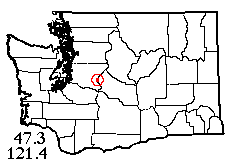 |
![]() 1 VIII 2007: Back in June, I gave a spider program at the Cedar
River Institute, and Tom Van Buren, who works with habitat management at
the Cedar
River Watershed (it supplies the lion's share of Seattle's water) offered
me collecting access to the closed-to-the-public areas. We and the weatherman
finally got together on a date so late in the season that I needed a spot over
5000 feet high to get a good sample. The spot we settled on really seems to
have no name. It is drained by Little Deer Creek (itself not on many maps);
for easy reference I'm going to call the peak Mosquito Mountain. Laurel and
I met Tom at the watershed offices and, using the director's SUV, we proceeded
up nearly the entire length of the watershed and switchbacked up the mountain
to a late-1990s clearcut just under the summit. Tom and I scrambled up the extremely
steep clearcut to the summit ridge, where Laurel (who'd taken the easier forested
route) joined us. My main goal, a meadow on the east side of the 5130-foot summit,
was easily found and turned out to be about 2/3 beargrass – very unusual.
Sweeping produced a few common meadow spiders plus Aculepeira packardi
and a Xysticus still being reared. The conifers around the edge were
better, and produced two Pityohyphantes spp. and to-date unidentified
Dictyna and Theridion. Laurel left us to check out a lower meadow
on the north slope shown on the aerial photo. She added no spider species there,
but found some fascinating terrain (see album).
After rejoining us, she decided to return to the car (maybe because of a mosquito
repellant shortage) and on the way down the clearcut she scored the two best
spiders of the trip, both jumping spiders: Pelegrina flavipedes and an
unidentified Phanias. Tom and I stayed in the summit area to sample conifer
litter (3 species), stumps and logs (5 species), and woody debris fallen from
snags, richest habitat of the trip with 8 species. These habitats produced 2
uncommon spiders limited to montane old-growth, Frederickus wilburi and
Lepthyphantes rainieri. Some collecting back down by the car added little,
but the upshot was a 26-species sample, or 1 species for every 2 of my mosquito
bites!
1 VIII 2007: Back in June, I gave a spider program at the Cedar
River Institute, and Tom Van Buren, who works with habitat management at
the Cedar
River Watershed (it supplies the lion's share of Seattle's water) offered
me collecting access to the closed-to-the-public areas. We and the weatherman
finally got together on a date so late in the season that I needed a spot over
5000 feet high to get a good sample. The spot we settled on really seems to
have no name. It is drained by Little Deer Creek (itself not on many maps);
for easy reference I'm going to call the peak Mosquito Mountain. Laurel and
I met Tom at the watershed offices and, using the director's SUV, we proceeded
up nearly the entire length of the watershed and switchbacked up the mountain
to a late-1990s clearcut just under the summit. Tom and I scrambled up the extremely
steep clearcut to the summit ridge, where Laurel (who'd taken the easier forested
route) joined us. My main goal, a meadow on the east side of the 5130-foot summit,
was easily found and turned out to be about 2/3 beargrass – very unusual.
Sweeping produced a few common meadow spiders plus Aculepeira packardi
and a Xysticus still being reared. The conifers around the edge were
better, and produced two Pityohyphantes spp. and to-date unidentified
Dictyna and Theridion. Laurel left us to check out a lower meadow
on the north slope shown on the aerial photo. She added no spider species there,
but found some fascinating terrain (see album).
After rejoining us, she decided to return to the car (maybe because of a mosquito
repellant shortage) and on the way down the clearcut she scored the two best
spiders of the trip, both jumping spiders: Pelegrina flavipedes and an
unidentified Phanias. Tom and I stayed in the summit area to sample conifer
litter (3 species), stumps and logs (5 species), and woody debris fallen from
snags, richest habitat of the trip with 8 species. These habitats produced 2
uncommon spiders limited to montane old-growth, Frederickus wilburi and
Lepthyphantes rainieri. Some collecting back down by the car added little,
but the upshot was a 26-species sample, or 1 species for every 2 of my mosquito
bites!
18 VIII 2007: The Scarabs beach trip to English Boom, visited earlier this year by Laurel and me, only managed to attract 5 people. The others must have been scared off by moist weather predictions that never materialized, at least where we were. Those who made the trip had a great time, with partly sunny weather and outstanding solitude. Numerous sand wasps were doing their thing à la Tinbergen, and Scarab Griswold nabbed several tiger beetles. Other catches or sights included histerid, coccinellid, and buprestid beetles; 4-5 butterfly species; a variety of bees including bumbles; ichneumonids; a horntail; both native and introduced paper wasps; Sympetrum dragonflies; katydids and many millions of grasshoppers (several species); and of course some weevils for Sharon. Not a raindrop fell until we were passing through Everett on the way home, when the clouds really opened up (briefly). For photos see the album from the prior trip.
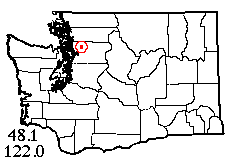 |
![]() 5 X 2007: On my own for the first part of October, I inaugurated fall
collecting with a bus trip to the southeast corner of the town of Arlington,
Snohomish County. From here, I hiked eastward into an unsampled area, Burn Hill
which is rapidly being converted from woods and fields into housing. I'd located
a powerline right of way (a usually reliable indicator of public access) along
a ridge crest, and hiked along this to the end of the clearing with grass and
herbs, forest on the sides, and a nice view northward of farmland in the Stillaguamish
Valley (see album). I sifted bigleaf maple litter
for a while and as usual got a number of species. While in sifting mode I decided
to sift some litter that was out in the clearing, and to my surprise got an
even better fauna including some rarities. There were few spiders on the cedar
foliage, but moss back in the forest was fairly productive, and understory ferns
yielded plenty. Two introduced orbweavers dominated the aerial webs. While sifting
meadow litter, I turned around to see a big black dog (no doubt from a nearby
house) watching me. I made friends with the dog, who eventually went away, all
without a single bark. By the time the grass was dry enough to sweep, getting
another diverse array of species, cows were mooing in the valley. Total for
the day (just over 4 hours on site), 35 spider species including one Walckenaeria
(see album) I didn't recognize. When the weather
permits, fall spider collecting is great!
5 X 2007: On my own for the first part of October, I inaugurated fall
collecting with a bus trip to the southeast corner of the town of Arlington,
Snohomish County. From here, I hiked eastward into an unsampled area, Burn Hill
which is rapidly being converted from woods and fields into housing. I'd located
a powerline right of way (a usually reliable indicator of public access) along
a ridge crest, and hiked along this to the end of the clearing with grass and
herbs, forest on the sides, and a nice view northward of farmland in the Stillaguamish
Valley (see album). I sifted bigleaf maple litter
for a while and as usual got a number of species. While in sifting mode I decided
to sift some litter that was out in the clearing, and to my surprise got an
even better fauna including some rarities. There were few spiders on the cedar
foliage, but moss back in the forest was fairly productive, and understory ferns
yielded plenty. Two introduced orbweavers dominated the aerial webs. While sifting
meadow litter, I turned around to see a big black dog (no doubt from a nearby
house) watching me. I made friends with the dog, who eventually went away, all
without a single bark. By the time the grass was dry enough to sweep, getting
another diverse array of species, cows were mooing in the valley. Total for
the day (just over 4 hours on site), 35 spider species including one Walckenaeria
(see album) I didn't recognize. When the weather
permits, fall spider collecting is great!
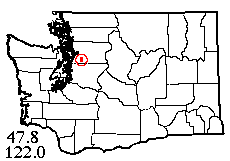 |
![]() 13 X 2007: The following week, I again took advantage of Snohomish County's
great bus system and headed northeast to Monroe; from the southwest corner of
town, I walked into a wooded area just outside Lord
Hill Regional Park (the abandoned road I was hiking was blocked by a huge
blackberry thicket before I actually reached the park). This must once have
been a great area, with lowland forest and natural balds, but the forest is
being swallowed by Himalayan blackberry, and the bald I was able to reach appears
about to be swallowed by a new rock quarry! Although I couldn't get far from
the road, roadside maples had great moss and leaf litter, and some remnants
of fern/salmonberry understory hung down the road's upper bank. A few spiders
were found under rocks around the quarry, and blackberry-free parts of the bald
provided good sweeping. The usual non-native orbweavers were common; the only
conifer foliage at the site was red cedar, not very productive. From my site,
a busy highway and a barking dog at the east base of the hill were all too audible,
but warm sunny weather, solitude and fall foliage compensated. I came away with
an even 40 species, but not including any rarities.
13 X 2007: The following week, I again took advantage of Snohomish County's
great bus system and headed northeast to Monroe; from the southwest corner of
town, I walked into a wooded area just outside Lord
Hill Regional Park (the abandoned road I was hiking was blocked by a huge
blackberry thicket before I actually reached the park). This must once have
been a great area, with lowland forest and natural balds, but the forest is
being swallowed by Himalayan blackberry, and the bald I was able to reach appears
about to be swallowed by a new rock quarry! Although I couldn't get far from
the road, roadside maples had great moss and leaf litter, and some remnants
of fern/salmonberry understory hung down the road's upper bank. A few spiders
were found under rocks around the quarry, and blackberry-free parts of the bald
provided good sweeping. The usual non-native orbweavers were common; the only
conifer foliage at the site was red cedar, not very productive. From my site,
a busy highway and a barking dog at the east base of the hill were all too audible,
but warm sunny weather, solitude and fall foliage compensated. I came away with
an even 40 species, but not including any rarities.
 |
![]() 23 X 2007: Laurel and I fulfilled a long-standing plan by collecting
along the Centralia Canal near the town of McKenna on the Nisqually River. We
reached the canal access road by hiking along railroad tracks. A beautiful and
secluded spot, but peaceful? Well...there must have been a war game going on
at nearby Fort Lewis! With us were two UW students, Jamal and Sean, who wanted
guidance to collect a lot of orbweavers for research. Hiking along the tracks
seemed quite an adventure to them. Once at the site everything went smoothly,
and collecting proceeded through the day with grass sweeping, tree beating,
litter and moss sifting, and collecting from webs, dead wood, understory, and
under stones. A canal-drainage gate (somewhat leaky) had a bridge over it with
lots of spiders on the railings. In the evening, a Holstein-colored cat from
a nearby house came down through the woods and carefully climbed down the bank
to drink from the canal! On examining the catch later, I was amazed to find
64 species (including unfamiliar species of Bathyphantes and Dictyna),
surely one of my richest one-day, one-site collections.
23 X 2007: Laurel and I fulfilled a long-standing plan by collecting
along the Centralia Canal near the town of McKenna on the Nisqually River. We
reached the canal access road by hiking along railroad tracks. A beautiful and
secluded spot, but peaceful? Well...there must have been a war game going on
at nearby Fort Lewis! With us were two UW students, Jamal and Sean, who wanted
guidance to collect a lot of orbweavers for research. Hiking along the tracks
seemed quite an adventure to them. Once at the site everything went smoothly,
and collecting proceeded through the day with grass sweeping, tree beating,
litter and moss sifting, and collecting from webs, dead wood, understory, and
under stones. A canal-drainage gate (somewhat leaky) had a bridge over it with
lots of spiders on the railings. In the evening, a Holstein-colored cat from
a nearby house came down through the woods and carefully climbed down the bank
to drink from the canal! On examining the catch later, I was amazed to find
64 species (including unfamiliar species of Bathyphantes and Dictyna),
surely one of my richest one-day, one-site collections.
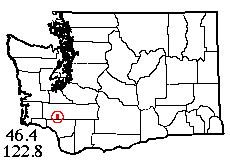 |
![]() 7 XI 2007: Back in 1991, my one-time assistant Karen Dorweiler took 5
spider species in a sweep sample while visiting relatives in the town of Toledo,
Washington. A return trip to supplement Karen's collection was especially inviting
on this day because online weather reports showed it as one of the few spots
in the state missed by last night's unexpected rain showers. What Laurel and
I hadn't bargained on was a traffic jam on the freeway between Maytown and Centralia
– we never learned what caused it. My brilliant idea of paralleling the
freeway on Old 99 worked out so well that an old lady walking with her cane
passed us! However, the sun was shining over Toledo, and access to my planned
site along the Cowlitz River was easy. The site was somewhat degraded (most
of the habitat in a 1990 aerial photo is now farmed) but it was too late in
the day to be picky. We swept tall grass and sedge along the river bank, and
Laurel found a nice fat Tegenaria agrestis under a stone. Much of the
riparian cottonwood belt had rather poor leaf litter, but I found one very good
patch with 15 spider species including the rare Micrargus aleuticus.
With an hour of daylight left, we adjourned to the Toledo town park, where park
buildings produced 5 rural house spider species and we beat a few others from
conifer foliage. The 32-species total and nice weather more than compensated
us for the traffic.
7 XI 2007: Back in 1991, my one-time assistant Karen Dorweiler took 5
spider species in a sweep sample while visiting relatives in the town of Toledo,
Washington. A return trip to supplement Karen's collection was especially inviting
on this day because online weather reports showed it as one of the few spots
in the state missed by last night's unexpected rain showers. What Laurel and
I hadn't bargained on was a traffic jam on the freeway between Maytown and Centralia
– we never learned what caused it. My brilliant idea of paralleling the
freeway on Old 99 worked out so well that an old lady walking with her cane
passed us! However, the sun was shining over Toledo, and access to my planned
site along the Cowlitz River was easy. The site was somewhat degraded (most
of the habitat in a 1990 aerial photo is now farmed) but it was too late in
the day to be picky. We swept tall grass and sedge along the river bank, and
Laurel found a nice fat Tegenaria agrestis under a stone. Much of the
riparian cottonwood belt had rather poor leaf litter, but I found one very good
patch with 15 spider species including the rare Micrargus aleuticus.
With an hour of daylight left, we adjourned to the Toledo town park, where park
buildings produced 5 rural house spider species and we beat a few others from
conifer foliage. The 32-species total and nice weather more than compensated
us for the traffic.
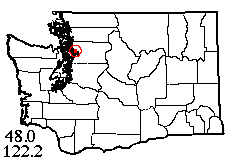 |
![]() 21 XI 2007: Across Possession Sound and the Snohomish estuary from Everett
is a semi-rural strip of coastline where I had no spider records. Since we had
a few sunny days before Thanksgiving and Laurel was out of town, a bus trip
seemed in order. The bus was scheduled to arrive at my site a little after noon
– actually it was nearly 1pm, giving me about 3 hours to collect. And with
a mostly-dry landscape all around, I'd picked a site that was sopping wet, perhaps
from heavy dew. Oh well, there I was. I hiked into the woods on a grass-grown,
log-blocked track mislabeled as a street by Google Earth, through the fringes
of a swamp and a lot of wet alder trees and salmonberry bushes, to find a nice
grove of maples and cedars on a side road. Here, the leaf litter was very rich
in spiders, almost guaranteeing me an adequate sample. I also sifted moss (only
semi-productive) and swept understory ferns that weren't too wet under the trees.
Other habitats produced little. To catch my bus I had to leave the site just
after 4, sweeping the wet grass and rushes on the way out until my net was soaked.
The total catch was 26 species, with only one that might be unusual.
21 XI 2007: Across Possession Sound and the Snohomish estuary from Everett
is a semi-rural strip of coastline where I had no spider records. Since we had
a few sunny days before Thanksgiving and Laurel was out of town, a bus trip
seemed in order. The bus was scheduled to arrive at my site a little after noon
– actually it was nearly 1pm, giving me about 3 hours to collect. And with
a mostly-dry landscape all around, I'd picked a site that was sopping wet, perhaps
from heavy dew. Oh well, there I was. I hiked into the woods on a grass-grown,
log-blocked track mislabeled as a street by Google Earth, through the fringes
of a swamp and a lot of wet alder trees and salmonberry bushes, to find a nice
grove of maples and cedars on a side road. Here, the leaf litter was very rich
in spiders, almost guaranteeing me an adequate sample. I also sifted moss (only
semi-productive) and swept understory ferns that weren't too wet under the trees.
Other habitats produced little. To catch my bus I had to leave the site just
after 4, sweeping the wet grass and rushes on the way out until my net was soaked.
The total catch was 26 species, with only one that might be unusual.
 |
![]() 7 XII 2007: Fall collecting is still productive in December – if
the weather cooperates. The day promised fair so Laurel and I headed to the
place where it had rained least recently, Marrowstone and Indian Islands off
the east coast of Jefferson County, reached via the Kingston Ferry (with a great
view of snowy Olympics) and Hood Canal Bridge. Most of Indian Island belongs
to the navy, but there is a public beach park at the south end. Beach habitats
here included littoral forest with madrona; sand with seaweed wrack to sift
(got Spirembolus and Erigone); driftwood of all sizes; small salt
marshes and extensive beach meadow. There were no spiders in the park outhouse
but several species on the outside. Total for this site, 15 species, including
a rare Ceraticelus that I'd previously taken only once.
7 XII 2007: Fall collecting is still productive in December – if
the weather cooperates. The day promised fair so Laurel and I headed to the
place where it had rained least recently, Marrowstone and Indian Islands off
the east coast of Jefferson County, reached via the Kingston Ferry (with a great
view of snowy Olympics) and Hood Canal Bridge. Most of Indian Island belongs
to the navy, but there is a public beach park at the south end. Beach habitats
here included littoral forest with madrona; sand with seaweed wrack to sift
(got Spirembolus and Erigone); driftwood of all sizes; small salt
marshes and extensive beach meadow. There were no spiders in the park outhouse
but several species on the outside. Total for this site, 15 species, including
a rare Ceraticelus that I'd previously taken only once.
![]() Continuing across a causeway to Marrowstone Island, we headed to Fort Flagler
at the north end where a coleopterist friend had collected 2 spider species
back in 1976. This historic park features different kinds of littoral forest,
lots of beach, and historic WW2 gun battery bunkers. We started collecting
at a very productive forest site but a few minutes later I suddenly realized
we were in the wrong end of the park to supplement those previous records! Just
in that short time we'd taken 12 species, and I haven't yet recognized one microspider
that Laurel swept from ferns. With under 2 hours of daylight left, we hurried
to the right area and I collected from litter, moss and ferns while Laurel checked
out the bunker across the road (finding several species on the walls) and beat
salal and conifers up above it. The leaf litter here was too cold for the spiders
to be very active, so I brought a bagful home for the Berlese funnel. We got
30 species from this site alone, making 42 with the beach collection and 44
with the prior records! A great day with fascinating terrain, lots of spiders
and no mosquitos at all. Just one minor fly in our ointment – clouds moved
in and cheated us of our sunset.
Continuing across a causeway to Marrowstone Island, we headed to Fort Flagler
at the north end where a coleopterist friend had collected 2 spider species
back in 1976. This historic park features different kinds of littoral forest,
lots of beach, and historic WW2 gun battery bunkers. We started collecting
at a very productive forest site but a few minutes later I suddenly realized
we were in the wrong end of the park to supplement those previous records! Just
in that short time we'd taken 12 species, and I haven't yet recognized one microspider
that Laurel swept from ferns. With under 2 hours of daylight left, we hurried
to the right area and I collected from litter, moss and ferns while Laurel checked
out the bunker across the road (finding several species on the walls) and beat
salal and conifers up above it. The leaf litter here was too cold for the spiders
to be very active, so I brought a bagful home for the Berlese funnel. We got
30 species from this site alone, making 42 with the beach collection and 44
with the prior records! A great day with fascinating terrain, lots of spiders
and no mosquitos at all. Just one minor fly in our ointment – clouds moved
in and cheated us of our sunset.
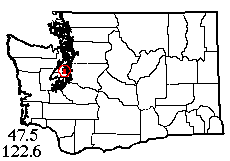 |
![]() 31 XII 2007: This year's largely dreadful December weather finally cleared
up for the very last day. No one else was available, so I took the ferry from
downtown Seattle to downtown Bremerton, hoping to find enough habitat in city
parks within walking distance to upgrade an old 9-species sample. Two wooded
parks were within reach, and I made the mistake of trying the nearer first.
As can be seen from the album, Evergreen Park was
almost entirely lacking in spider habitat. Even the little leaf litter I was
able to find was spider-free. So off to the other end of town and Forest Ridge
Park. Habitat there was rather low-grade: the leaf litter layer seemed to be
thin everywhere, invasive ivy was abundant and blackberry by no means uncommon.
The restroom building seemed to have no house spiders at all, just a couple
of juvenile orbweavers. Nonetheless, I got enough species from 2 kinds of litter,
fir and understory foliage, and a little moss on madrona trunks to upgrade the
Bremerton sample to 25 species. There was even a Bathyphantes-like spider
I couldn't immediately identify. I also met a park ranger (at least, so he claimed,
though he had no insignia or ID) who clearly thought I was some kind of wacko,
even after all explanations. Definitely time for a haircut!
31 XII 2007: This year's largely dreadful December weather finally cleared
up for the very last day. No one else was available, so I took the ferry from
downtown Seattle to downtown Bremerton, hoping to find enough habitat in city
parks within walking distance to upgrade an old 9-species sample. Two wooded
parks were within reach, and I made the mistake of trying the nearer first.
As can be seen from the album, Evergreen Park was
almost entirely lacking in spider habitat. Even the little leaf litter I was
able to find was spider-free. So off to the other end of town and Forest Ridge
Park. Habitat there was rather low-grade: the leaf litter layer seemed to be
thin everywhere, invasive ivy was abundant and blackberry by no means uncommon.
The restroom building seemed to have no house spiders at all, just a couple
of juvenile orbweavers. Nonetheless, I got enough species from 2 kinds of litter,
fir and understory foliage, and a little moss on madrona trunks to upgrade the
Bremerton sample to 25 species. There was even a Bathyphantes-like spider
I couldn't immediately identify. I also met a park ranger (at least, so he claimed,
though he had no insignia or ID) who clearly thought I was some kind of wacko,
even after all explanations. Definitely time for a haircut!
That's all, folks - 27 field days in 2007.
This page last updated 21 March, 2025